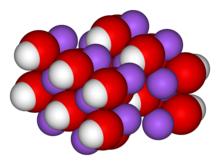
Back Natriumhidroksied Afrikaans هيدروكسيد الصوديوم Arabic Hidróxidu de sodiu AST سودیوم هیدروکسید AZB Натриев хидроксид Bulgarian সোডিয়াম হাইড্রোক্সাইড Bengali/Bangla Natrij-hidroksid BS Hidròxid de sodi Catalan Hydroxid sodný Czech Натрий гидроксичĕ CV
 | |

| |
| Names | |
|---|---|
| IUPAC name
Sodium hydroxide[3]
| |
| Other names | |
| Identifiers | |
3D model (JSmol)
|
|
| ChEBI | |
| ChemSpider | |
| ECHA InfoCard | 100.013.805 |
| EC Number |
|
| E number | E524 (acidity regulators, ...) |
| 68430 | |
| KEGG | |
| MeSH | Sodium+Hydroxide |
PubChem CID
|
|
| RTECS number |
|
| UNII | |
| UN number | 1823 (solid) 1824 (solution) |
CompTox Dashboard (EPA)
|
|
| |
| |
| Properties | |
| NaOH | |
| Molar mass | 39.9971 g/mol |
| Appearance | White, opaque crystals |
| Odor | odorless |
| Density | 2.13 g/cm3[4] |
| Melting point | 323 °C (613 °F; 596 K)[4] |
| Boiling point | 1,388 °C (2,530 °F; 1,661 K)[4] |
| 418 g/L (0 °C) 1000 g/L (25 °C)[4] 3370 g/L (100 °C) | |
| Solubility | soluble in glycerol, negligible in ammonia, insoluble in ether, slowly soluble in propylene glycol |
| Solubility in methanol | 238 g/L |
| Solubility in ethanol | <<139 g/L |
| Vapor pressure | <2.4 kPa (20 °C) 0.1 kPa (700 °C) |
| Acidity (pKa) | 15.7 |
| −15.8·10−6 cm3/mol (aq.)[5] | |
Refractive index (nD)
|
1.3576 |
| Structure[6] | |
| Orthorhombic, oS8 | |
| Cmcm, No. 63 | |
a = 0.34013 nm, b = 1.1378 nm, c = 0.33984 nm
| |
Formula units (Z)
|
4 |
| Thermochemistry[7] | |
Heat capacity (C)
|
59.5 J/(mol·K) |
Std molar
entropy (S⦵298) |
64.4 J/(mol·K) |
Std enthalpy of
formation (ΔfH⦵298) |
−425.8 kJ/mol |
Gibbs free energy (ΔfG⦵)
|
-379.7 kJ/mol |
| Hazards | |
| GHS labelling: | |
 
| |
| Danger | |
| H290, H302, H314 | |
| P280, P305+P351+P338, P310 | |
| NFPA 704 (fire diamond) | |
| Lethal dose or concentration (LD, LC): | |
LD50 (median dose)
|
40 mg/kg (mouse, intraperitoneal)[9] 140 - 340 mg/kg (rat, oral) 1350 mg/kg (rabbit, dermal) |
LDLo (lowest published)
|
500 mg/kg (rabbit, oral)[10] |
| NIOSH (US health exposure limits): | |
PEL (Permissible)
|
TWA 2 mg/m3[8] |
REL (Recommended)
|
C 2 mg/m3[8] |
IDLH (Immediate danger)
|
10 mg/m3[8] |
| Safety data sheet (SDS) | External SDS |
| Related compounds | |
Other anions
|
|
Other cations
|
|
Related compounds
|
|
Except where otherwise noted, data are given for materials in their standard state (at 25 °C [77 °F], 100 kPa).
| |
Sodium hydroxide, also known as lye and caustic soda,[1][2] is an inorganic compound with the formula NaOH. It is a white solid ionic compound consisting of sodium cations Na+ and hydroxide anions OH−.
Sodium hydroxide is a highly corrosive base and alkali that decomposes lipids and proteins at ambient temperatures and may cause severe chemical burns. It is highly soluble in water, and readily absorbs moisture and carbon dioxide from the air. It forms a series of hydrates NaOH·nH2O.[11] The monohydrate NaOH·H2O crystallizes from water solutions between 12.3 and 61.8 °C. The commercially available "sodium hydroxide" is often this monohydrate, and published data may refer to it instead of the anhydrous compound.
As one of the simplest hydroxides, sodium hydroxide is frequently used alongside neutral water and acidic hydrochloric acid to demonstrate the pH scale to chemistry students.[12]
Sodium hydroxide is used in many industries: in the making of wood pulp and paper, textiles, drinking water, soaps and detergents, and as a drain cleaner. Worldwide production in 2022 was approximately 83 million tons.[13]
- ^ a b "Material Safety Datasheet" (PDF). certified-lye.com. Archived from the original (PDF) on 2008-02-28. Retrieved 2010-02-24.
- ^ a b "Material Safety Datasheet 2" (PDF). hillbrothers.com. Archived from the original (PDF) on 2012-08-03. Retrieved 2012-05-20.
- ^ a b "Sodium Hydroxide – Compound Summary". Retrieved June 12, 2012.
- ^ a b c d Haynes, p. 4.90
- ^ Haynes, p. 4.135
- ^ Jacobs, H.; Kockelkorn, J. and Tacke, Th. (1985). "Hydroxide des Natriums, Kaliums und Rubidiums: Einkristallzüchtung und röntgenographische Strukturbestimmung an der bei Raumtemperatur stabilen Modifikation". Z. Anorg. Allg. Chem. 531 (12): 119–124. doi:10.1002/zaac.19855311217.
{{cite journal}}: CS1 maint: multiple names: authors list (link) - ^ Haynes, p. 5.13
- ^ a b c NIOSH Pocket Guide to Chemical Hazards. "#0565". National Institute for Occupational Safety and Health (NIOSH).
- ^ Michael Chambers. "ChemIDplus – 1310-73-2 – HEMHJVSKTPXQMS-UHFFFAOYSA-M – Sodium hydroxide [NF] – Similar structures search, synonyms, formulas, resource links, and other chemical information.". nih.gov.
- ^ "Sodium hydroxide". Immediately Dangerous to Life or Health Concentrations (IDLH). National Institute for Occupational Safety and Health (NIOSH).
- ^ Cite error: The named reference
siemwas invoked but never defined (see the help page). - ^ "Examples of Common Laboratory Chemicals and their Hazard Class". Archived from the original on 2018-01-10. Retrieved 2018-01-09.
- ^ https://www.chemanalyst.com/industry-report/caustic-soda-market-681
